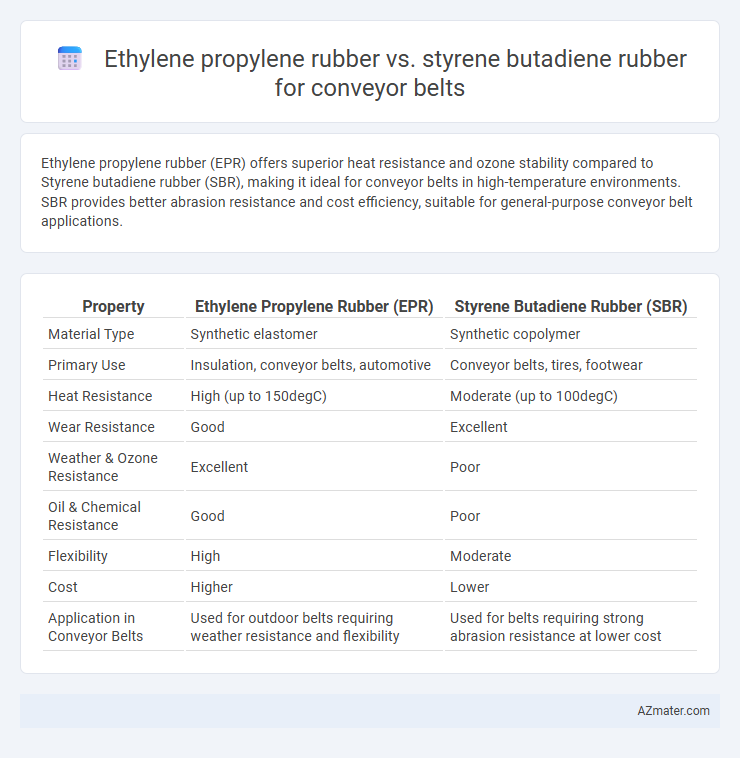Ethylene propylene rubber (EPR) offers superior heat resistance and ozone stability compared to Styrene butadiene rubber (SBR), making it ideal for conveyor belts in high-temperature environments. SBR provides better abrasion resistance and cost efficiency, suitable for general-purpose conveyor belt applications.
Table of Comparison
| Property | Ethylene Propylene Rubber (EPR) | Styrene Butadiene Rubber (SBR) |
|---|---|---|
| Material Type | Synthetic elastomer | Synthetic copolymer |
| Primary Use | Insulation, conveyor belts, automotive | Conveyor belts, tires, footwear |
| Heat Resistance | High (up to 150degC) | Moderate (up to 100degC) |
| Wear Resistance | Good | Excellent |
| Weather & Ozone Resistance | Excellent | Poor |
| Oil & Chemical Resistance | Good | Poor |
| Flexibility | High | Moderate |
| Cost | Higher | Lower |
| Application in Conveyor Belts | Used for outdoor belts requiring weather resistance and flexibility | Used for belts requiring strong abrasion resistance at lower cost |
Introduction to Conveyor Belt Materials
Ethylene propylene rubber (EPR) offers excellent heat resistance, ozone resistance, and flexibility, making it ideal for conveyor belts operating in high-temperature or outdoor environments. Styrene butadiene rubber (SBR) provides superior abrasion resistance and cost-effectiveness, which suits conveyor belts handling heavy loads and abrasive materials. Selecting between EPR and SBR depends on specific conveyor conditions, with EPR favored for durability under harsh elements and SBR chosen for mechanical wear resilience.
Overview of Ethylene Propylene Rubber (EPR)
Ethylene Propylene Rubber (EPR) offers superior resistance to heat, ozone, and weathering compared to Styrene Butadiene Rubber (SBR), making it ideal for conveyor belts operating in harsh environmental conditions. EPR's enhanced electrical insulation properties and excellent flexibility at low temperatures ensure long-lasting performance and durability. This material's high resistance to oxidation and chemical exposure contributes to reduced maintenance and extended conveyor belt lifespan in industrial applications.
Overview of Styrene Butadiene Rubber (SBR)
Styrene Butadiene Rubber (SBR) is a synthetic rubber commonly used in conveyor belts due to its excellent abrasion resistance and good aging stability, especially in dry environments. It offers superior mechanical properties, including high tensile strength and resilience, making it ideal for heavy-duty conveyor applications. SBR is cost-effective and widely preferred over Ethylene Propylene Rubber (EPR) when oil resistance is less critical, providing durability and reliability in general-purpose conveyor belt systems.
Mechanical Properties Comparison: EPR vs SBR
Ethylene propylene rubber (EPR) exhibits superior resistance to heat, ozone, and weathering compared to styrene butadiene rubber (SBR), making it highly durable for conveyor belt applications in harsh environments. SBR offers enhanced abrasion resistance and tensile strength, which contributes to improved wear performance and longevity under heavy mechanical stress. Overall, EPR's elasticity and flexibility favor dynamic loads, while SBR's toughness excels in high-friction conditions, influencing the choice based on specific operational demands.
Abrasion and Wear Resistance Differences
Ethylene propylene rubber (EPR) offers superior abrasion and wear resistance compared to styrene butadiene rubber (SBR), making it more suitable for conveyor belts exposed to harsh operating conditions. EPR's enhanced molecular structure provides better resistance to surface degradation, extending belt lifespan under abrasive materials. SBR, while cost-effective and flexible, tends to wear faster due to lower abrasion resistance, resulting in more frequent replacements and maintenance.
Chemical Resistance: EPR vs SBR
Ethylene propylene rubber (EPR) exhibits superior chemical resistance compared to styrene butadiene rubber (SBR), making it more suitable for conveyor belts exposed to acids, alkalis, and oxidizing agents. EPR's saturated polymer backbone offers enhanced stability against harsh chemicals, whereas SBR's unsaturated structure is prone to degradation from oils, solvents, and ozone. This chemical resistance difference significantly impacts the longevity and maintenance requirements of conveyor belts in aggressive industrial environments.
Temperature and Weather Performance
Ethylene propylene rubber (EPR) excels in extreme temperature resistance, maintaining flexibility from -50degC to 150degC, making it ideal for conveyor belts exposed to harsh weather conditions and fluctuating temperatures. Styrene butadiene rubber (SBR) performs well in moderate climates but tends to harden and crack below -30degC and degrade faster under UV exposure and ozone, limiting its durability in severe weather. EPR's superior weathering resistance and ozone stability ensure longer conveyor belt lifespan in outdoor and variable temperature applications compared to SBR.
Cost and Availability Considerations
Ethylene propylene rubber (EPR) generally offers higher cost efficiency compared to styrene butadiene rubber (SBR) due to its longer lifespan and better resistance to weathering, reducing replacement frequency for conveyor belts. SBR, widely available and commonly used in conveyor belt applications, tends to have lower upfront costs but may incur higher long-term expenses because of its lower durability under harsh conditions. The availability of raw materials for SBR is broader globally, making it more accessible in cost-sensitive markets, whereas EPR's specialized production limits its supply but justifies the premium through enhanced performance.
Typical Conveyor Belt Applications for EPR and SBR
Ethylene propylene rubber (EPR) is commonly used in conveyor belts for outdoor and industrial applications due to its superior resistance to heat, ozone, and weathering, making it ideal for mining and bulk material handling. Styrene butadiene rubber (SBR) is preferred in conveyor belts requiring abrasion resistance and tensile strength, typically found in general material transport and packaging industries. Both EPR and SBR offer different advantages depending on environmental exposure and load conditions, influencing conveyor belt system durability and performance.
Choosing the Right Rubber Material for Your Conveyor System
Ethylene propylene rubber (EPR) offers superior resistance to heat, ozone, and weathering, making it ideal for conveyor belts exposed to harsh environmental conditions and high temperatures. Styrene butadiene rubber (SBR) provides excellent abrasion resistance and cost-effectiveness, suitable for general-purpose conveyor belts handling dry, abrasive materials. Selecting the right rubber material depends on the conveyor's operating environment, temperature range, and material conveyed, with EPR preferred for durability in extreme conditions and SBR favored for wear resistance and budget-sensitive applications.

Infographic: Ethylene propylene rubber vs Styrene butadiene rubber for Conveyor belt
 azmater.com
azmater.com